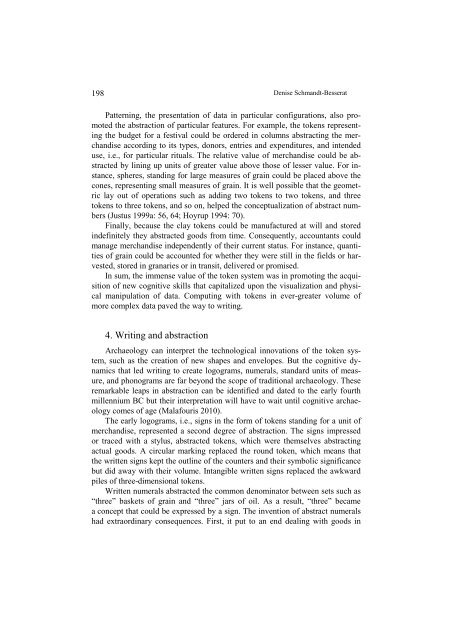s - Wyższa SzkoÅa Filologiczna we WrocÅawiu
s - Wyższa SzkoÅa Filologiczna we WrocÅawiu
s - Wyższa SzkoÅa Filologiczna we WrocÅawiu
Create successful ePaper yourself
Turn your PDF publications into a flip-book with our unique Google optimized e-Paper software.
198<br />
Denise Schmandt-Besserat<br />
Patterning, the presentation of data in particular configurations, also promoted<br />
the abstraction of particular features. For example, the tokens representing<br />
the budget for a festival could be ordered in columns abstracting the merchandise<br />
according to its types, donors, entries and expenditures, and intended<br />
use, i.e., for particular rituals. The relative value of merchandise could be abstracted<br />
by lining up units of greater value above those of lesser value. For instance,<br />
spheres, standing for large measures of grain could be placed above the<br />
cones, representing small measures of grain. It is <strong>we</strong>ll possible that the geometric<br />
lay out of operations such as adding two tokens to two tokens, and three<br />
tokens to three tokens, and so on, helped the conceptualization of abstract numbers<br />
(Justus 1999a: 56, 64; Hoyrup 1994: 70).<br />
Finally, because the clay tokens could be manufactured at will and stored<br />
indefinitely they abstracted goods from time. Consequently, accountants could<br />
manage merchandise independently of their current status. For instance, quantities<br />
of grain could be accounted for whether they <strong>we</strong>re still in the fields or harvested,<br />
stored in granaries or in transit, delivered or promised.<br />
In sum, the immense value of the token system was in promoting the acquisition<br />
of new cognitive skills that capitalized upon the visualization and physical<br />
manipulation of data. Computing with tokens in ever-greater volume of<br />
more complex data paved the way to writing.<br />
4. Writing and abstraction<br />
Archaeology can interpret the technological innovations of the token system,<br />
such as the creation of new shapes and envelopes. But the cognitive dynamics<br />
that led writing to create logograms, numerals, standard units of measure,<br />
and phonograms are far beyond the scope of traditional archaeology. These<br />
remarkable leaps in abstraction can be identified and dated to the early fourth<br />
millennium BC but their interpretation will have to wait until cognitive archaeology<br />
comes of age (Malafouris 2010).<br />
The early logograms, i.e., signs in the form of tokens standing for a unit of<br />
merchandise, represented a second degree of abstraction. The signs impressed<br />
or traced with a stylus, abstracted tokens, which <strong>we</strong>re themselves abstracting<br />
actual goods. A circular marking replaced the round token, which means that<br />
the written signs kept the outline of the counters and their symbolic significance<br />
but did away with their volume. Intangible written signs replaced the awkward<br />
piles of three-dimensional tokens.<br />
Written numerals abstracted the common denominator bet<strong>we</strong>en sets such as<br />
“three” baskets of grain and “three” jars of oil. As a result, “three” became<br />
a concept that could be expressed by a sign. The invention of abstract numerals<br />
had extraordinary consequences. First, it put to an end dealing with goods in
















